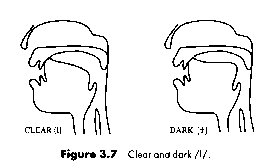 ] before [
] before [ ], or between [u] and
[
], or between [u] and
[ ], or [e] and [
], or [e] and [ ]. Rogers argues that it
must be the tense vowel that occurs in this environment, assuming that all
vowels before [
]. Rogers argues that it
must be the tense vowel that occurs in this environment, assuming that all
vowels before [ ]
must have the same tenseness and that diphthongs are tense.
]
must have the same tenseness and that diphthongs are tense.
 ]").
]").
For example, there is no contrast between [i] and [ ] before [
] before [ ], or between [u] and
[
], or between [u] and
[ ], or [e] and [
], or [e] and [ ]. Rogers argues that it
must be the tense vowel that occurs in this environment, assuming that all
vowels before [
]. Rogers argues that it
must be the tense vowel that occurs in this environment, assuming that all
vowels before [ ]
must have the same tenseness and that diphthongs are tense.
]
must have the same tenseness and that diphthongs are tense.
There is in fact a great deal of dialect variability in this. In my own
speech, can only occur after lax vowels (or occur
syllabically):
| peer | ![[pIr]](peer.gif)
|
| pear | ![[pEr]](pear.gif)
|
| poor | ![[pUr]](poor.gif) or or ![[pOr]](pour.gif)
|
| pour | ![[pOr]](pour.gif)
|
| par | ![[pAr]](par.gif)
|
| purr | ![[pr]](purr.gif)
|
 ] as a lax vowel.) [
] as a lax vowel.) [ ] cannot occur after diphthongs, but must be syllabic in
a second syllable:
] cannot occur after diphthongs, but must be syllabic in
a second syllable:
| pyre | ![[paj.r]](pyre.gif)
|
| power | ![[paw.r]](power.gif)
|
| naive | ![[na.iv]](naive.gif)
|
| knife | ![[najf]](knife.gif)
|
| employ | ![[6m.ploj]](employ.gif)
|
| employee | ![[6m.plo.i]](employee.gif)
|
 ]
]

We could symbolize by putting the "velarized" diacritc after [l], but it's
a common enough sound to have a special symbol: [ ].
].
Warning: Don't confuse this with the voiceless lateral fricative symbol, [].
Remember to try the calligraphy exercises in the back of Rogers.
- The dark (velarized) L symbol has a simple ~ squiggle through it. You have to take your pen off the page in order to write it.
- The voiceless lateral fricative symbol loops back and crosses itself. You can write it without taking your pen off the page.
Why would it make sense to use dark L after back vowels?
| house (verb) | ![[hawz]](house-v.gif)
|
| house (noun) | ![[h^ws]](house-n.gif)
|
| eyes | ![[ajz]](eyes.gif)
|
| ice | ![[^js]](ice.gif)
|
Before voiceless consonants, the starting point of the diphthongs is
raised from [a] to [ ].
].

Why does it make sense for this raising to happen before voiceless
consonants rather than before voiced?